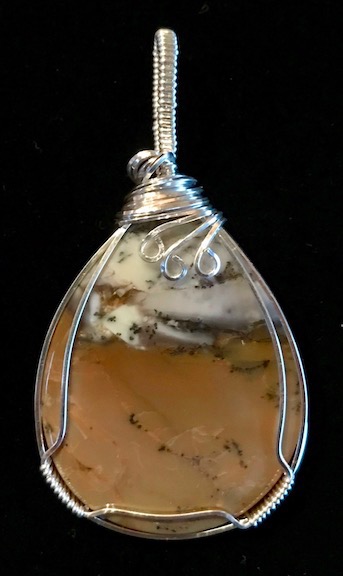Surprisingly successful.
I started creating wire-wrapped jewelry back in January of this year. I’ve come a long way.
Getting Serious and Developing a Style

My first wire-wrapped jewelry piece. Don’t laugh; I was proud of it back then. And I still think those are excellent swirls.
My first attempts were predictably amateurish. Cringe-worthy, in fact, when looking back on them. I learned from watching a few YouTube videos — which, in hindsight, I now realize were the wrong YouTube videos. But I had a lot of positive feedback from the people who saw my work, including some professionals. (I was in Quartzsite, AZ at the time and literally surrounded by rock hounds and lapidaries.) I realize now that they were probably just being nice. That early stuff was gawdawful, although I subsequently did manage to sell every single piece. (Go figure, eh?)
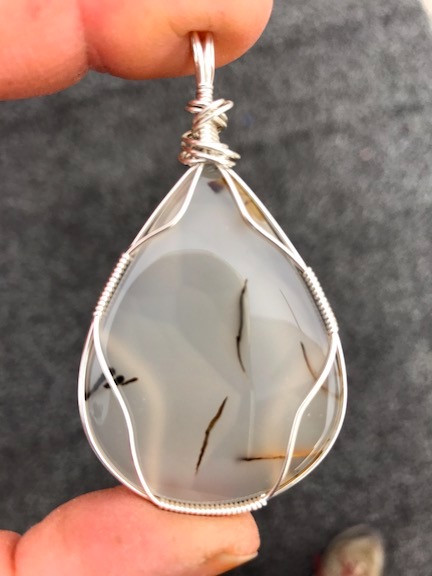
Finishing this first piece in sterling silver was when I think I started getting serious. That was a really beautiful stone. It was one of the first pieces I sold.
In mid January, I got a lesson from a friend who is one of those professionals. Dorothy guided me to create my first piece in sterling silver. I think this was the point at which I realized that if I wanted to acquire nice stones, I needed to get serious about creating nice jewelry with them. The things I learned really helped put me on the right path.
At around the same time, I found another YouTube wire-wrap artist who showed me additional techniques, such as wire-wrapped bails, that I’d incorporate into my own work to develop my own style. That style now includes hand-formed swirls at the top of each piece, an occasional drop-down wire or two that end in tiny loops, and a pair of tiny loops at the back of the piece.
Since January, I’ve created well over 100 pieces of wire-wrapped gemstone jewelry, most of which are wrapped with silver. I’ve shifted slowly from the inexpensive stones I acquired in Quartzsite to more exotic, higher quality stones I get from gemstone dealers and at gem shows.
It’s All about the Stones
For me, it’s all about the stones. I’ve always liked beautiful stones but never had a reason to acquire them. Making jewelry gives me an excuse to buy stones. I put them on display in cases so I can look at them and choose one for my next piece. It seems silly to folks who don’t have a thing for stones, but if you do, I’m sure you know exactly what I mean.
Of course, these stones aren’t cheap and I really didn’t want to continue funding this — dare I say it? — obsession with stones. So I decided to try to sell my jewelry.
The Birth of ML Jewelry Designs
I did a few things pretty much all at once:
- I came up with a company name. I needed a name so I could identify the company. I’m afraid I didn’t get very creative. I put about 10 minutes of thought into it. ML Jewelry Designs.
- I registered a domain name. Honestly, I don’t know why so many businesses put their eggs in the Facebook basket. There’s nothing that gives a company more legitimacy than an address on the web. So MLJewelryDesigns.com was born.
- I set up a Facebook page. (I later pretty much abandoned it when I decided that I’d had enough of Facebook. I did the same for my other company, Flying M Air, LLC.)
- I set up a Twitter account for the company. I wanted a way to tweet only company news, including photos and links to new pieces.
- I registered my business with the state. I knew I’d have to collect and pay sales tax.
- I built a website with WordPress. What else was I going to use?
- I started photographing my jewelry and adding it with descriptions to the website.
- I set up WordPress to automatically tweet posts about new pieces.
- I set up Square to accept credit card payments and, more importantly, an online store.
- I designed and bought materials for unique packaging that included clear pillow boxes and card inserts.
All this took less than a week. Maintaining the website and online store to add jewelry pieces would take a few hours every week.
I got my first online sale within a week. It was to a Twitter friend who lived overseas. (Thank you, mdy!) As I packed up the piece, I found myself kind of sad to see it go. But I felt less sad when I saw the money in my bank account and placed another order for stones. It’s all about the stones!
Selling in Person
The one thing I knew for sure is that the photos of my work that I was putting online did not do the pieces justice. They look way better in real life. That was confirmed when I showed photos to several shop owners and got a lukewarm response. (I don’t do that anymore. I tell people I don’t have photos with me.) One of those shop owners saw them in person yesterday and was very impressed.
I knew that Pybus Public Market, a local shop/restaurant/farmer’s market venue on the Wenatchee waterfront, had “day tables” for vendors. The rates were affordable. Some friends of mine were already selling handmade furniture and other woodworking items there on Saturdays. I decided too see if I could get a table there.
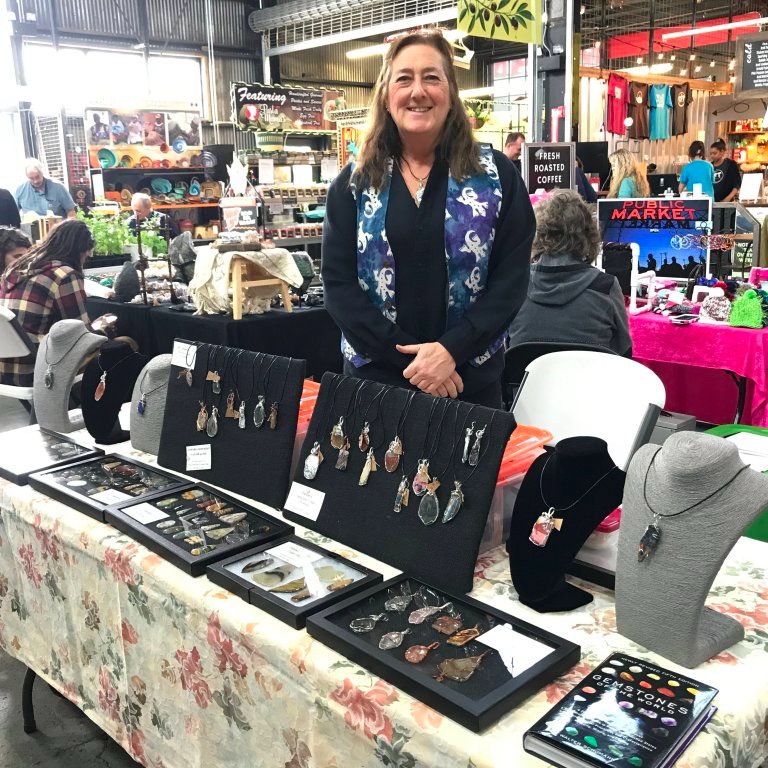
My first table at Pybus Public Market. I now use a black tablecloth and have really improved my display.
It was remarkably easy, especially in the spring when there wasn’t much of a demand for space. I set up one Saturday for the first time. My table consisted of several jewelry display busts with pendants hung around them and black burlap-covered boards with the pendants on display. I had the stones on display, too, all priced so folks could buy stones to take with them or have me wrap for them.
And I sold three pieces of jewelry.
Now that might not seem like a lot, but I’m not making cheap stuff. My prices range from $49 to $59 for most pieces, with a few cheaper ones (clearance items and quick wraps for folks on a budget) and a few more expensive ones (especially lately with the high quality stones I’ve been acquiring). The cost of the table was cheap enough that if I sold just one piece, I’d be ahead of the game. I considered three a good day.
I came back other Saturdays with mixed results. None of the Saturdays were bad, but some were better than others.
After talking to other vendors, I decided to try Fridays. With the exception of one day that no one did well — they didn’t even charge our table fees that day — I did fine.
Saturdays got busier when the Wenatchee Valley Farmer’s Market started up outside. That didn’t necessarily mean more people were spending money indoors, though. It was hit or miss, but never a complete failure. It did start getting better when the Seattle weekenders started coming in.
When the Wednesday evening farmer’s market started last week, I started coming on Wednesdays, too. I sold two pieces the first time — and I had to leave at 2 because of weather. (I’m still cherry drying pilot.) I sold four this past Friday. And I sold five yesterday.
Although I sit there making jewelry as I chat with shoppers, vendors, and employees, I often sell more pieces than I can make in the same time. Sometimes the jewelry I’m making is a special order for someone who really liked a stone in one of my cases and wanted a jewelry piece made from it.
I get lots of complements from everyone who stops to look, even if they don’t buy. (After all, I know that not everyone is interested in wearing a pretty rock on a cord around their neck.)
And a shopper yesterday, as I gave her my usual spiel — “I buy the stones already cut and polished. I do all the wire work to make the pendants and earrings in sterling silver, copper, or both.” — said, “I know. My friend told me about you.”
Whoa. Word of mouth. How cool is that?
The Gallery
Of course, a better way to sell my jewelry was to have someone else sell it for me. So I continued looking for places that might take my work.
I quickly learned not to use the phrase “wire wrap” when describing my jewelry to a shop owner. And not to show photos. The best way to approach a shop owner was to go in when it wasn’t crowded with my case of finished pieces.
You see, I store all my pieces in a glass-topped jewelry display case when it’s not on display on the labeled board at Pybus. The case has dividers and each piece fits into a slot on black velvet. It looks neat and impressive.

This piece of Native Silver sold at the Two Rivers Art Gallery last week.
And that’s what I took into the Two Rivers Art Gallery when I went to ask if they’d display them — despite the fact that the manager told me they had no room for me when I called him on the phone. They were suitably impressed and they made room. I’ve got a whole shelf in a locked case in one of the front rooms. And last week, I got a check for the sale of two pieces of jewelry, including my most expensive piece (Native Silver), which sold for $89.
But I’m not done. I’m hoping to get my jewelry into a handful of other stores in the area and beyond. (If you’re reading this and am interested in helping me sell my work in your store, please get in touch.)
Looking Ahead
I’m always looking for ways to improve my display with the goal of increasing sales at events.
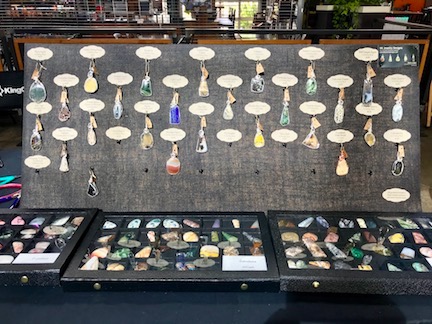
Here’s my current display board with some of the cabochon cases in front of them. (And yes, it’s a terrible photo.)
Over time, I modified my display to include a bigger board, labeled hooks that included the name of the stone and the price (so people wouldn’t have to fumble with the tag or unnecessarily touch anything), and lights. There was an easel to lift and tilt the board without having to depend on boxes behind it. My selling junk (iPad, Square, packaging, etc.) is hidden behind the easel, leaving the table neat. The three gemstone display boxes, which have plexiglas tops, are unsnapped so they can be easily opened to remove a stone for inspection by someone who is seriously interested, while keeping kids and light-fingered passersby from touching or taking home souvenirs. Not perfect, but better.
I’m also looking into other venues, specifically one where artwork is displayed and sold. I have a lead on an “Artisan’s Booth” at the Grant County Fair in August and am still sitting on the fence about it. I suspect I’ll give it a try just to see what it’s like, even though I don’t think it’s the kind of crowd my work would appeal to.
I’d like to get into some events in a metropolitan area like Seattle where people are willing to spend more money.
Meanwhile, I’m buying more rocks. I can’t tell you how many complements I get on my selection of stones.
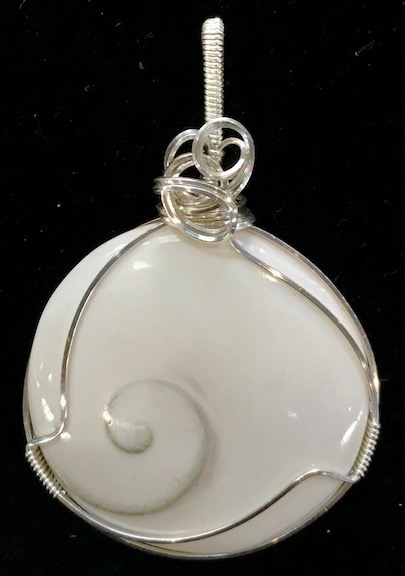
The second Shiva shell piece I made yesterday sold, too.
And since I’m starting to learn what sells best, I’m making sure I always have pieces using those stones in stock. Kingman turquoise, Shiva shell, rose quartz, lapis lazuli, and K2 are nearly impossible to keep in stock. On Thursday night, I made a Shiva shell piece and it sold on Friday. On Saturday, I made one and it sold before I was finished. I made a second one and it sold before I packed up. I have one on order for my best customer and need to make at least two more — one for the gallery and one for Wednesday at Pybus. So you can guess what I’ll be doing this evening — or this afternoon when the wind invariably kicks up. (What is it with the wind this year?)
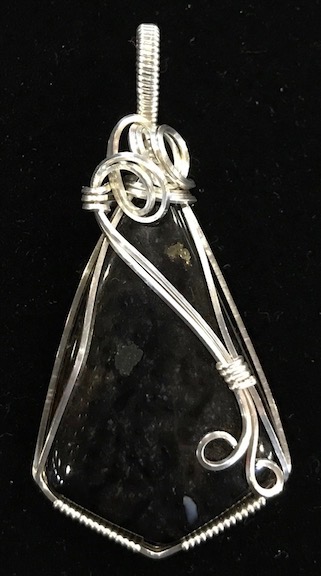
This little piece of black pyrite came out a lot better than I expected it to and is currently my favorite piece.
I need to stress that I enjoy making the jewelry. I find it strangely relaxing and rewarding, especially when a piece comes out better than I expected it to. I’ve never felt so creative before. Artistic, even. And although I’m kind of sad to see a piece I really like get sold, I’m also thrilled every time I make a sale. I’m creating something visual (as opposed to the millions of words I’ve sold as a writer) that people want to buy. How cool is that?
So at this point, I think it’s safe to say that this is not just a passing phase for me. I feel invested and rewarded and even still excited about this work. I’m looking forward to continuing and improving my technique and style for years to come.

